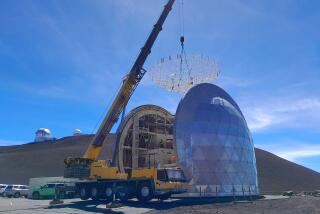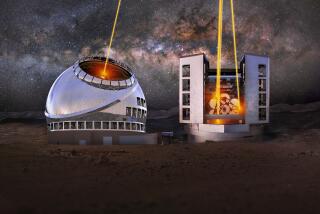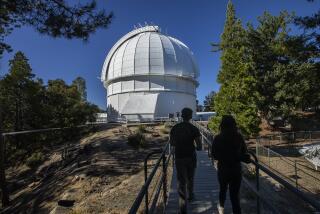Modern Earthly Problems Weigh on Observatory’s Heavenly Site
WILLIAMS BAY, Wis. — For more than a century, professional astronomers and amateur stargazers have made the pilgrimage to this small lakeside village with dreams of discovering the secrets of the universe.
Overlooking the blue waters of Lake Geneva is the Yerkes Observatory, a renowned research facility and home to the world’s largest refractor telescope. Its 40-inch lens has lured Albert Einstein, Edwin Hubble and Carl Sagan to peer through its eyepiece and study the constellations.
But over the decades, dwindling funds and a growing problem with light pollution has hampered astronomers’ work.
Now, the University of Chicago -- which owns the observatory -- has decided to sell it and the 77 acres of land that surround it.
The question of what it should be in its next life is being contested.
On one side is an anonymous East Coast real estate developer, who has offered an estimated $10 million and a plan to build dozens of high-end vacation homes and a luxury spa. On the other is a coalition of area residents and a local university, which insists that the land and the observatory’s ornate facility be preserved.
“The observatory is woven into the spirit and soul of this area,” said Larry Larkin, 67, an engineer and one of five local residents spearheading their bid to buy Yerkes. “We regard it as a treasure, a jewel. The thought of homes being built all around and altering the fabric of Yerkes is disturbing.”
Yerkes was the dream of George Ellery Hale. A pioneering astronomer who later made his mark in California, Hale was recruited by the University of Chicago in the 1890s; the school promised to build him an observatory. Charles Tyson Yerkes, a Chicago railway financier hungry to create a legacy, agreed to pay for the construction.
Though several locations were considered -- including one in California -- it was preferable to stay closer to the university’s campus. A donor helped arrange for the site in Wisconsin, a sprawling section of wooded land on the northwest edge of Lake Geneva, about 75 miles from Chicago.
Artists were brought in to decorate the tan brick building and the graceful domes that anchor each end.
Outside, terra cotta columns are covered with carvings about the size of a man’s hand. Lions and rams, and other animals of the zodiac, stare somberly at visitors. Moonscapes vie for space with Minotaurs and other creatures of Greek mythology.
Inside the building, wooden floors are worn by decades of foot traffic and the rooms warmed by sunlight cutting through stained glass windows.
Completed in 1897, the building’s massive domes and looming telescopes were far enough from the haze of Chicago and researchers could get there relatively easily by train from the school’s campus.
Until the mid-1960s, the technology here, as well as its relative isolation, made it ideal to house the university’s astronomy department. Much of the focus was on tracking star movements, using both the refractor telescope and other telescopic instruments to photograph far away star systems.
Scores of astronomers, including those who discovered new moons of Uranus and Neptune, came here to work and contemplate celestial mysteries.
“This was one of the birthplaces of modern astronomy,” said Kyle M. Cudworth, director of the observatory. “Practically every introductory astronomy textbook has a picture of the refractor telescope and Yerkes.”
Over time, more people moved to the rural Lake Geneva region, building homes and small businesses -- and creating light pollution.
Today, there are about 2,500 residents in Williams Bay, a cozy resort town where residents stop their cars to let mallard ducks cross the road.
“We have a low population and high property values,” said James D’Alessandro, a former village board member who has spent most of his life in the area. “This is the place people come to from the city to get away.”
That’s why developers and university officials say what surrounds the observatory is arguably more valuable than the building itself: The 77 acres includes a stretch of about 500 feet of shoreline property, one of the last and largest sections of undeveloped land on Lake Geneva.
At least half of the property is limited in its use by steep slopes as well as environmental and zoning issues, according to Larkin.
The land cuts a swath through the holdings of Aurora University, whose 240-acre George Williams campus sits on either side of Yerkes.
“There’s University of Chicago land on part of our golf course. We use some of their wooded areas in our wilderness classes,” said Rebecca L. Sherrick, president of Aurora University. “It’s all been fine since the 1890s. Then that changed last summer, when we began hearing rumors that Chicago was contemplating this sale.”
Most of the observatory’s 23 staff members are working on a camera that NASA will use to track and take infrared images. The center has expanded its educational outreach programs, and regularly uses its research library and reflector telescopes to train teachers throughout the region.
But the observatory’s main draw, the refractor telescope, is out of commission. The digital directional displays, used to set latitude and longitude, fizzled out several years ago.
So the cash-strapped scientists have reverted to using the telescope’s original tools to set the coordinates of a particular star: two massive metal wheels, about the size of a small car, that move the steel cylinder either north-south or east-west.
But there’s also a problem with a motorized driver, which allows the telescope to keep up with the Earth’s rotation while tracking stars. “We think it might be broken, or it might just need to be cleaned,” said Cudworth, who expects it to be working by this summer. “We’re in the process of repairing it and lubing the gears.”
Such problems prove that Yerkes’ heyday has passed in the research world, said university spokesman Larry Arbeiter.
“If it were actively being used, it would not be allowed to get into that condition,” Arbeiter said. “The observatory simply can no longer do what we need it to do: to push forward the boundaries of knowledge.”
Last August, university officials disclosed that a developer had approached the school about the observatory, and eventually the two reached an agreement for a reported $10 million. Cudworth and other Yerkes staff members attended a meeting with school officials, who presented artistic renderings of what was to come.
“They thought we might become a museum where tourists could walk through and see things,” Cudworth said. “They didn’t acknowledge any of the other work we’re doing here.”
When local residents heard about the impending sale, many were outraged. Larkin’s group contacted the university, which agreed to postpone the sale while alternative offers were made.
The residents, later joined by officials from Aurora University and the Adler Planetarium in Chicago, offered a range of prices for the property.
“Essentially, we don’t want to pay for land that can’t be developed because of either zoning or environmental restrictions,” Larkin said.
The goal is have the bulk of the land turned over to Aurora University. The observatory, and acres of land around it, would be managed by Adler Planetarium.
Observatory staff members could continue to pursue their research efforts, thanks to government grants or other funding sources.
University of Chicago officials say they are still weighing their options.
“Clearly, there is value in the observatory on an architectural and cultural level,” Arbeiter said. “We’re still deciding what to do.”
More to Read
Sign up for Essential California
The most important California stories and recommendations in your inbox every morning.
You may occasionally receive promotional content from the Los Angeles Times.










